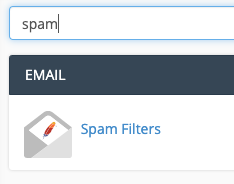Knowledge base article
Configure spam filtering in cPanel
View other domains and DNS articles
Related articles
An introduction to email authentication
Emptying Trash, Junk and Spam files
How to ensure website generated emails are delivered successfully
Other domains and DNS articles
A beginners guide to email spoofing
Accessing your site before changing DNS
An introduction to email authentication
Can I test out your services for free?
Cancel auto renewal on a domain registration
Complete a manual Change of Registrant (CoR) application for a .au domain
Domain options for shared hosting
Download or restore individual files, directories or database backups with JetBackup
Eligibility requirements for .au domains
Enabling PHP extensions, Changing PHP Version and Setting PHP Options
Finding your domain password/EPP code
Force HTTPS via .htaccess (cPanel)
Getting started with our DNS Manager
Hide .html extension using .htaccess
How to ensure website generated emails are delivered successfully
How to issue a Let’s Encrypt certificate
Install or manage complimentary SSL certificates with AutoSSL
Manage DNS zones with the cPanel Zone Editor
Migrate remote staging website to local hosting server
Migrate remote transactional website to local server
My site and/or email service is down
Network Firewall (I can’t access my services on a non-standard port)
Pointing your domain to Serversaurus
Pointing your domain to Squarespace with cPanel
Reconfigure production website to subdomain
Register or hold a .AU domain using a Trust
Subdomains for test sites & more
The SLA – Best effort versus 99.9% versus 100%
Transfer your domain to Serversaurus
Unable to renew certificate: The Let’s Encrypt HTTP challenge failed
Understanding CloudLinux resource limits
Update your domain contact information
Using Serversaurus’ nameservers but hosting your email elsewhere
What happens if my domain expires?
This article will guide you through using the Spam Filters function in cPanel
Spam Filters is a great feature in cPanel which allows you to adjust how incoming mail is being handled by your cPanel account. If you're experiencing issues with spam, a good first step to getting your spam issue under control is adjusting your Spam Filters settings to be more aggressive when identifying spam.
Let's get started! To follow this guide you need your cPanel login credentials. If you have forgotten your cPanel credentials, they were included in the original Welcome to Serversaurus or IMPORTANT: Hosting Documentation email which you should find in your inbox, otherwise follow these instructions on how to update your cPanel password.
- Login to cPanel and navigate to the Spam Filters function, use the search bar to assist you

- Enable the Spam Filter by selecting the button next to Process New Emails and Mark them as Spam

- To adjust the spam filters to be more or less aggressive, select Spam Threshold Score, then choose your preference from the drop down list, 10 being the least aggressive and 1 being the most

- To continue configuring the spam filter, select Return to "Overview"

- Choose from the options available, such as enabling Move New Spam to a Separate Folder (Spam Box) or Automatically Delete New Spam (Auto-Delete). You can also whitelist or blacklist email addresses, by navigating to the Additional Configurations (For Advanced Users) and adding email addresses or domains to the whitelist or blacklist.
If after adjusting the spam filter settings your issues persist, sometimes the inbuilt cPanel spam filter is not advanced enough to tackle all spam, so consider our SpamExperts Professional Spam Filter which is an addon available for your cPanel account or a dedicated email service such as our Dedicated Email Hosting or Google Workspace which both have excellent inbound spam filtering.
Published April 26, 2019. Last updated November 30, 2023.
Can't find what you're looking for?
"*" indicates required fields